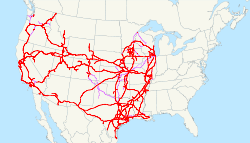
Back سكك حديد يونيون باسيفيك Arabic Union Pacific Railroad Byelorussian Union Pacific Railroad Czech Rheilffordd Union Pacific Welsh Union Pacific Railroad Danish Union Pacific Railroad German Union Pacific Railroad Esperanto Union Pacific Spanish Union Pacific Railroad Basque راهآهن یونیون پاسیفیک Persian
 | |
 System map (trackage rights in purple) | |
 UP 2723 leading a train eastbound near inland California. | |
| Overview | |
|---|---|
| Parent company | Union Pacific Corporation |
| Headquarters | Union Pacific Center, Omaha, Nebraska, United States |
| Key people |
|
| Founder | U.S. Congress |
| CEO | Jim Vena |
| Reporting mark | UP (road locomotives), UPP (passenger cars), UPY (yard locomotives) |
| Locale | Western, Midwestern and Southern United States |
| Dates of operation | 1862–present
|
| Technical | |
| Track gauge | 4 ft 8+1⁄2 in (1,435 mm) standard gauge |
| Length | 32,100 miles (51,700 km) |
| Other | |
| Website | up.com |
The Union Pacific Railroad (reporting marks UP, UPP, UPY) is a Class I freight-hauling railroad that operates 8,300 locomotives over 32,200 miles (51,800 km) routes in 23 U.S. states west of Chicago and New Orleans. Union Pacific is the second largest railroad in the United States after BNSF, with which it shares[2] a duopoly on transcontinental freight rail lines in the Western, Midwestern and West South Central United States.
Founded in 1862, the original Union Pacific Rail Road was part of the first transcontinental railroad project, later known as the Overland Route. Over the next century, UP absorbed the Missouri Pacific Railroad, the Western Pacific Railroad, the Missouri–Kansas–Texas Railroad and the Chicago, Rock Island and Pacific Railroad. In 1995, the Union Pacific merged with Chicago and North Western Transportation Company, completing its reach into the Upper Midwest. In 1996, the company merged with Southern Pacific Transportation Company, itself a giant system that was absorbed by the Denver and Rio Grande Western Railroad. The Union Pacific Railroad Company is the principal operating company of Union Pacific Corporation, which are both headquartered at the Union Pacific Center, in Omaha, Nebraska.
- ^ "EMPLOYER STATUS DETERMINATION Union Pacific Railroad Company Southern Pacific Transportation Company" (PDF). Railroad Retirement Board. Archived from the original (PDF) on June 8, 2022. Retrieved February 5, 2022.
- ^ "Company Overview". Union Pacific Corporation. December 31, 2013. Retrieved March 27, 2014.